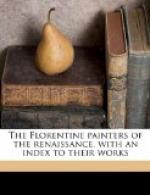It would be difficult to find more effective illustration of all that has just been said about movement than one or two of Pollaiuolo’s own works, which, in contrast to most of his achievements, where little more than effort and research are visible, are really masterpieces of life-communicating art. Let us look first at his engraving known as the “Battle of the Nudes.” What is it that makes us return to this sheet with ever renewed, ever increased pleasure? Surely it is not the hideous faces of most of the figures and their scarcely less hideous bodies. Nor is it the pattern as decorative design, which is of great beauty indeed, but not at all in proportion to the spell exerted upon us. Least of all is it—for most of us—an interest in the technique or history of engraving. No, the pleasure we take in these savagely battling forms arises from their power to directly communicate life, to immensely heighten our sense of vitality. Look at the combatant prostrate on the ground and his assailant bending over, each intent on stabbing the other. See how the prostrate man plants his foot on the thigh of his enemy, and note the tremendous energy he exerts to keep off the foe, who, turning as upon a pivot, with his grip on the other’s head, exerts no less force to keep the advantage gained. The significance of all these muscular strains and pressures is so rendered that we cannot help realising them; we imagine ourselves imitating all the movements, and exerting the force required for them—and all without the least effort on our side. If all this without moving a muscle, what should we feel if we too had exerted ourselves! And thus while under the spell of this illusion—this hyperaesthesia not bought with drugs, and not paid for with cheques drawn on our vitality—we feel as if the elixir of life, not our own sluggish blood, were coursing through our veins.
[Page heading: “HERCULES STRANGLING DAVID”]
Let us look now at an even greater triumph of movement than the Nudes, Pollaiuolo’s “Hercules Strangling Antaeus.” As you realise the suction of Hercules’ grip on the earth, the swelling of his calves with the pressure that falls on them, the violent throwing back of his chest, the stifling force of his embrace; as you realise the supreme effort of Antaeus, with one hand crushing down upon the head and the other tearing at the arm of Hercules, you feel as if a fountain of energy had sprung up under your feet and were playing through your veins. I cannot refrain from mentioning still another masterpiece, this time not only of movement, but of tactile values and personal beauty as well—Pollaiuolo’s “David” at Berlin. The young warrior has sped his stone, cut off the giant’s head, and now he strides over it, his graceful, slender figure still vibrating with the rapidity of his triumph, expectant, as if fearing the ease of it. What lightness, what buoyancy we feel as we realise the movement of this wonderful youth!




